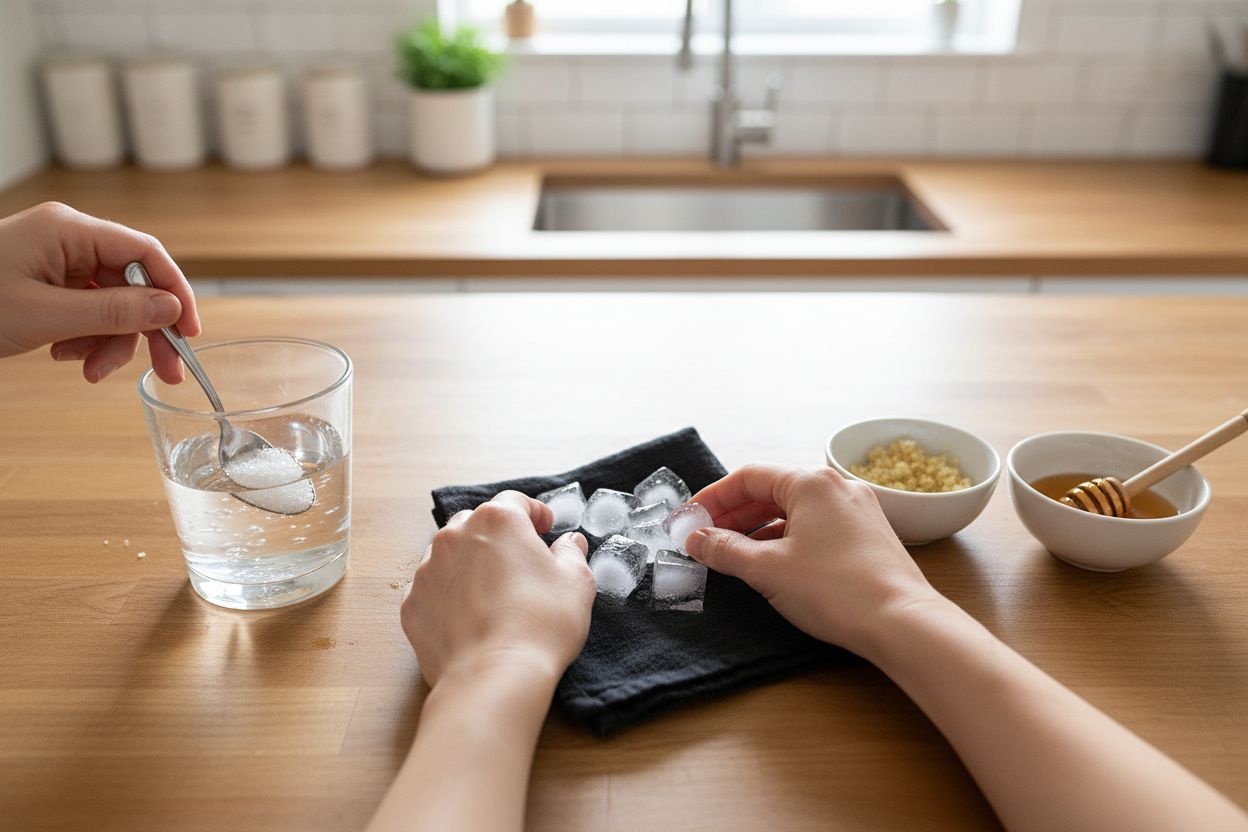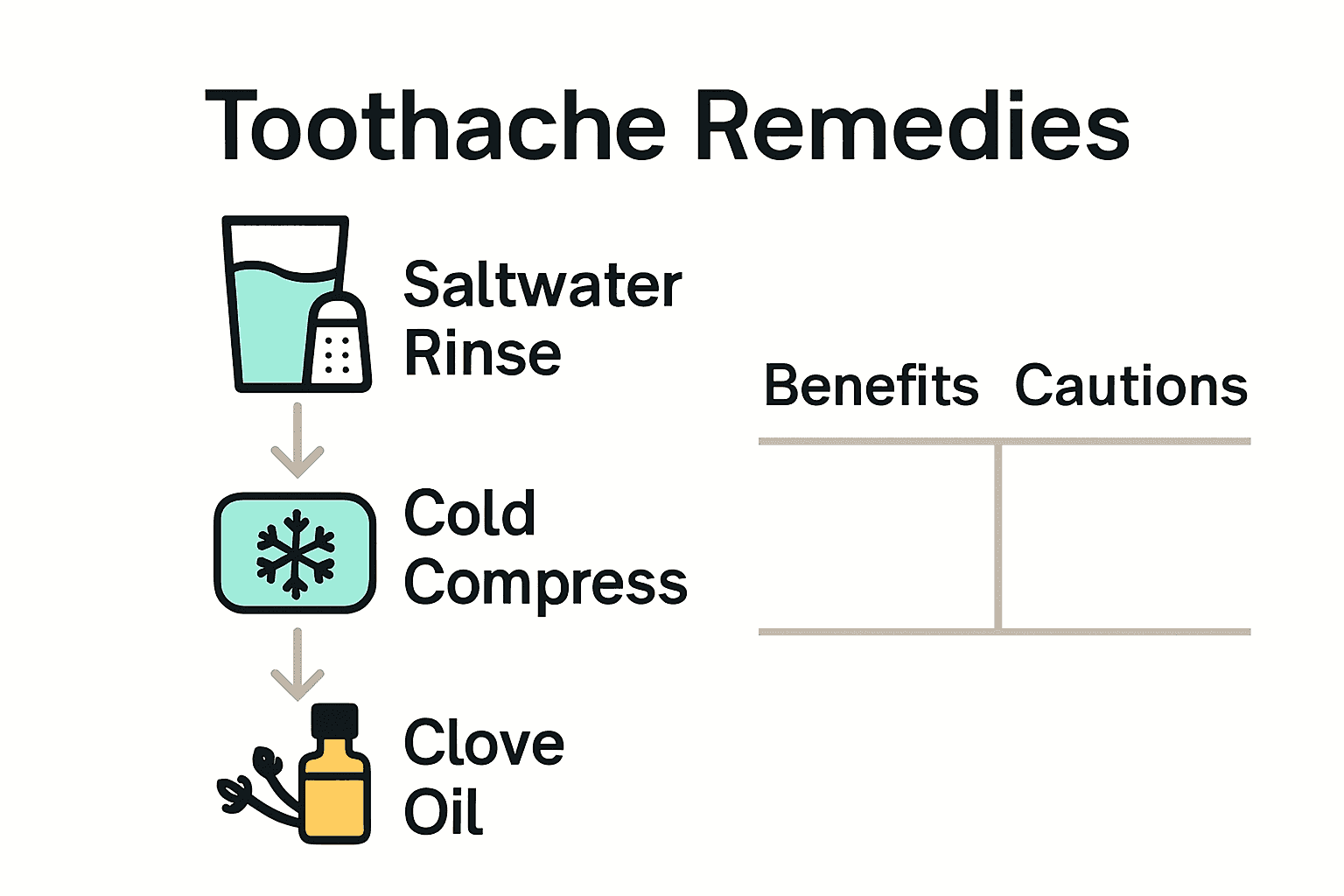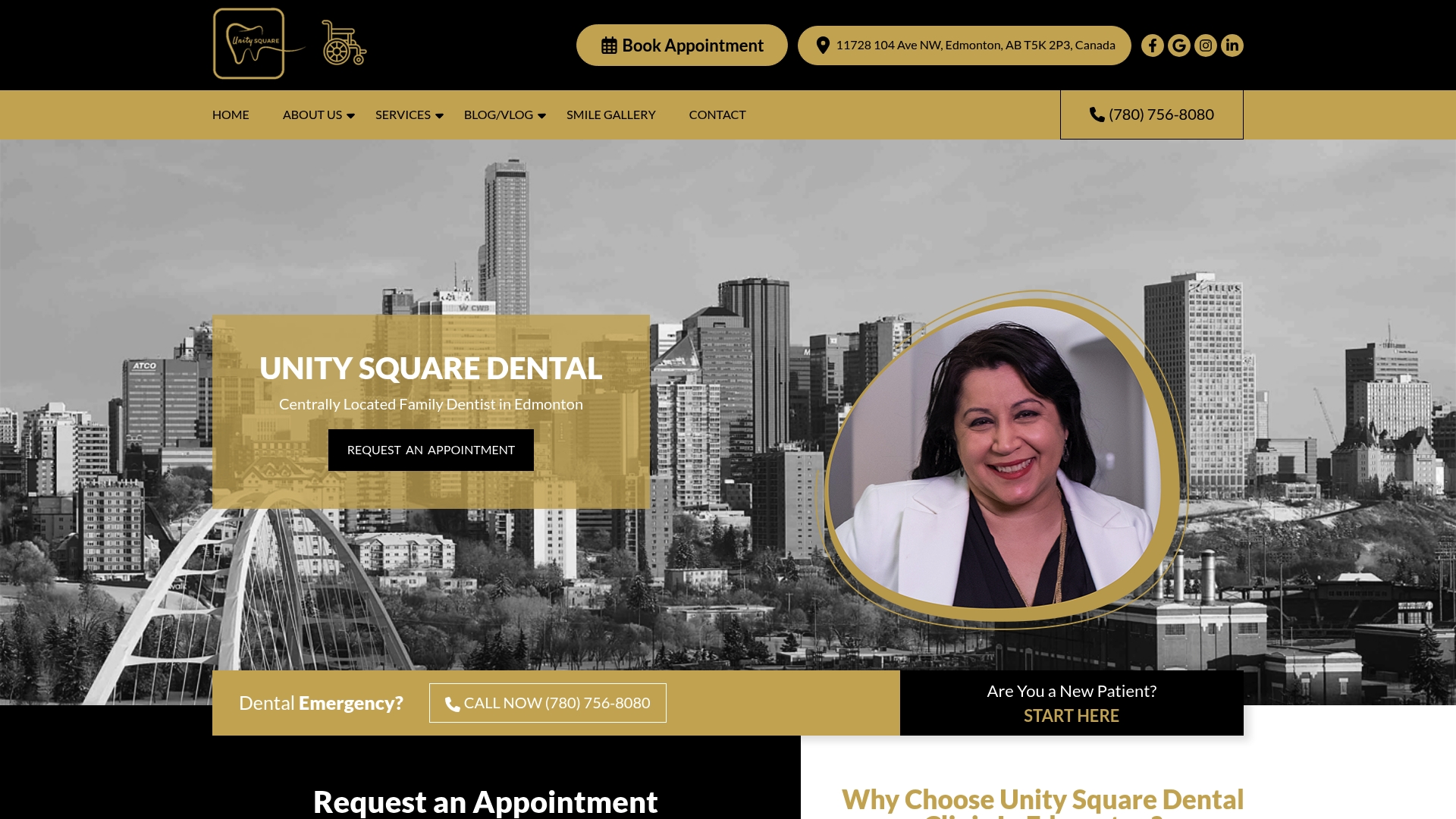
Did you know that over 90 percent of adults experience tooth pain at some point in their lives? Toothaches can strike suddenly, disrupting your day and making simple tasks difficult. Understanding how to assess pain, apply safe home remedies, and recognize urgent warning signs empowers you to manage discomfort wisely and protect your dental health. This guide will walk you through practical steps for quick pain relief and show you when to seek expert help.
Quick Summary
| Key Point | Explanation |
|---|---|
| 1. Assess toothache severity quickly | Evaluate pain characteristics to determine if you need urgent dental care or can manage at home. |
| 2. Use natural remedies for temporary relief | Home remedies like saltwater rinses and cold compresses can provide immediate, short-term comfort while awaiting professional help. |
| 3. Avoid aggravating foods and activities | Steer clear of hard, sugary, or very hot/cold foods to prevent further irritation of the affected tooth. |
| 4. Maintain gentle oral hygiene | Use a soft-bristled toothbrush and alternative cleaning methods to keep your mouth clean without adding pain. |
| 5. Seek professional help when needed | If symptoms persist or worsen, such as swelling, fever, or severe pain, contact a dentist immediately to prevent complications. |
Table of Contents
- Step 1: Assess Toothache Severity And Identify Triggers
- Step 2: Apply Natural Remedies To Soothe Pain
- Step 3: Avoid Aggravating Foods And Activities
- Step 4: Maintain Oral Hygiene With Gentle Care
- Step 5: Monitor Symptoms And Seek Professional Help
Step 1: Assess Toothache Severity and Identify Triggers
This step helps you understand the severity of your toothache and pinpoint potential triggers before deciding on treatment. By carefully evaluating your symptoms, you can determine whether you need professional dental care or can manage the pain at home.
Start by carefully examining the pain characteristics. According to research from the Cleveland Clinic, not all toothaches are created equal. Minor toothaches might feel like a slight irritation or temporary discomfort. However, more serious toothaches often present with specific warning signs.
Look for key indicators of severity. Sharp, throbbing, or persistent pain accompanied by fever, swelling, or chills typically signals a more serious underlying condition such as a cavity or potential infection. These symptoms suggest you should seek professional dental care quickly.
Identify potential triggers by considering common causes. Delta Dental outlines several potential sources of tooth pain:
- Cavities
- Dental abscesses
- Cracked or damaged teeth
- Gum disease
- Teeth grinding (bruxism)
- Damaged dental work
- Physical trauma
- Sinus related issues
Pro Tip: Keep a pain journal noting when the pain occurs, its intensity, and any potential triggers. This information can be incredibly helpful for your dentist.
If your pain is severe, continuous, or accompanied by significant swelling or fever, schedule an emergency dental appointment immediately. For more information on managing tooth pain, read our guide on natural tooth pain relief.
In the next step, we will explore immediate home remedies to help manage your tooth discomfort while preparing for professional evaluation.
Step 2: Apply Natural Remedies to Soothe Pain
Natural remedies can offer temporary relief while you wait for professional dental treatment. By using simple household ingredients, you can help reduce pain, manage inflammation, and provide some comfort during a toothache.
According to Health, several at-home remedies can help manage tooth pain effectively. Start with a saltwater rinse. Mix a half teaspoon of salt in a cup of warm water and gently swish around your mouth for about 30 seconds. This helps clean the affected area and reduce bacterial growth.
Cold compresses work wonders for managing pain and swelling. Wrap an ice pack or frozen vegetables in a clean towel and apply to your cheek near the painful tooth. The cold helps numb the area and reduce inflammation. Apply for 15-20 minutes at a time, taking breaks to prevent skin damage.

Some natural substances offer remarkable pain relief properties. Consider these options:
- Garlic: Crush a clove and apply directly to the painful area
- Honey: Known for antibacterial properties
- Peppermint: Can help numb and soothe pain
- Aloe vera: Reduces inflammation
Caution: While these remedies provide temporary relief, they are not substitutes for professional dental care.
One particularly interesting remedy is clove oil. Very Well Health notes that clove oil contains eugenol, which offers short-term numbness and antibacterial effects. However, use sparingly and avoid ingesting, as it can cause irritation or allergic reactions.
For more comprehensive pain management strategies, check out our detailed guide on natural tooth pain relief.
Here’s a comparison of common at-home tooth pain remedies:
| Remedy | How to Use | Key Benefits | Precautions |
|---|---|---|---|
| Saltwater Rinse | Swish 30 sec, spit out | Cleans area Reduces bacteria |
Do not swallow |
| Cold Compress | Apply 15-20 min to cheek | Reduces pain Minimizes swelling |
Protect skin from ice |
| Garlic | Crush, apply to sore spot | Antibacterial Pain relief |
May irritate gums |
| Honey | Dab on affected area | Soothes Antibacterial |
Use sparingly (sugar) |
| Peppermint | Place leaf or tea bag on tooth | Numbs Soothes discomfort |
Allergies possible |
| Aloe Vera | Apply gel to area | Reduces inflammation | Use pure gel only |
| Clove Oil | Dab small amount with cotton | Numbs Antibacterial |
Irritation risk if overused |
In the next step, we will discuss when and how to seek professional dental intervention to address the root cause of your toothache.

Step 3: Avoid Aggravating Foods and Activities
Reducing additional pain and preventing further damage during a toothache requires strategic food choices and activity modifications. Your goal is to minimize irritation and protect the sensitive tooth area while promoting healing.
According to the Times of India, refined carbohydrates can be just as harmful to your teeth as sugar. These include white bread, chips, sweetened cereals, and sugary yogurts. They essentially feed harmful bacteria and contribute to tooth decay.
When experiencing a toothache, Payless Dental recommends avoiding several types of foods that can worsen your discomfort:
- Sugary foods and drinks
- Acidic items like citrus fruits
- Hard or crunchy snacks
- Extremely hot or cold beverages
- Sticky candies or foods
- Tough meats
Instead, focus on soft lukewarm foods that are gentle on your teeth. Think smooth yogurt, mashed potatoes, scrambled eggs, and well cooked pasta. These options provide nutrition without causing additional pain.
Pro Tip: Drink water after meals to help rinse away food particles and reduce bacterial growth.
Beyond diet, certain activities can also aggravate tooth pain. Avoid extreme temperature changes, intense physical activities that might increase blood flow to the affected area, and anything that puts direct pressure on the painful tooth.
For more comprehensive guidance on managing dental discomfort, explore our detailed tooth pain relief strategies.
In the next step, we will discuss when it becomes critical to seek professional dental intervention and what signs indicate an urgent situation.
Step 4: Maintain Oral Hygiene with Gentle Care
When dealing with a toothache, maintaining oral hygiene becomes both critical and challenging. Your goal is to keep your mouth clean and reduce inflammation without causing additional pain or irritation.
According to Very Well Health, gentle oral care is essential during dental discomfort. Use a soft bristled toothbrush and brush carefully around the sensitive area. If traditional brushing feels too painful, consider alternative cleaning methods.
Wikipedia suggests an innovative solution for painful oral situations: oral care swabs. These foam swabs allow you to clean and moisturize oral tissues without risking further bleeding or discomfort. They can be particularly helpful when standard brushing is too painful.
Additional gentle cleaning techniques include:
- Saltwater rinses
- Gentle circular brushing motions
- Using lukewarm water
- Avoiding aggressive scrubbing
Pro Tip: If brushing causes significant pain, consult your dentist about temporary alternative cleaning methods.
Some people explore additional methods like oil pulling or baking soda rinses. However, use these techniques cautiously and sparingly. Not all home remedies work for everyone, and some might cause additional irritation.
Learn more about proper brushing techniques for sensitive teeth to prevent future discomfort and maintain optimal oral health.
In our final step, we will discuss when professional dental intervention becomes necessary and how to prepare for your appointment.
Step 5: Monitor Symptoms and Seek Professional Help
Knowing when to transition from home care to professional dental intervention is crucial for preventing serious complications. Your ability to recognize warning signs could make the difference between a simple treatment and a complex medical situation.
According to the Cleveland Clinic, you should seek immediate dental care if your toothache persists for more than two days or becomes unbearable. Some symptoms demand urgent attention and signal potential serious infections.
The Times of India highlights critical warning signs that require professional evaluation:
- Throbbing or sharp localized pain
- Pain that changes with body posture
- Jaw or gum related symptoms
- Increased tooth sensitivity
- Persistent bad breath
- Fever or chills
Pro Tip: Document your symptoms chronologically to help your dentist understand the progression of your pain.
If you experience facial swelling, difficulty opening your mouth fully, or signs of systemic infection like fever and chills, schedule an emergency dental appointment immediately. These could indicate a spreading infection that requires prompt medical intervention.
Learn more about our emergency dental services to understand how we can help you during urgent dental situations.
Remember that while home remedies provide temporary relief, they are not substitutes for professional dental care. Your dentist can diagnose and treat the underlying cause of your toothache effectively.
Don’t Let Tooth Pain Control Your Life: Get Expert Relief in Edmonton
Tired of guessing if your toothache needs urgent care or if home remedies are enough? Many people struggle with tooth pain management. The discomfort, worry about infection, and uncertainty about next steps can feel overwhelming. Our article outlined how to spot when at-home approaches work and when professional help is essential. At Unity Square Dental, we understand toothaches can disrupt your sleep, your routine, and your peace of mind. That is why we offer modern solutions for every step of your dental journey and provide the personalized care Edmonton families trust.

Stop living with dental discomfort. Book your visit with Unity Square Dental today through our main site and take advantage of gentle emergency care, advanced treatments, and a team that puts your comfort first. If you are looking for more resources about tooth pain management or want to read about our approach to natural tooth pain relief, we have you covered. Secure your relief and get back to smiling with confidence. Schedule an appointment now for the caring, expert dental support you deserve.
Frequently Asked Questions
How can I assess the severity of my toothache?
To assess the severity of your toothache, evaluate the pain characteristics such as its sharpness, consistency, and any accompanying symptoms like swelling or fever. Keep a pain journal to track these details over a few days, which will help you decide if professional care is necessary.
What natural remedies can I use for toothache relief?
You can use saltwater rinses, cold compresses, or natural substances like garlic and clove oil for temporary relief. Try swishing a mixture of half a teaspoon of salt in warm water for 30 seconds, or apply a cold pack to your cheek for 15-20 minutes.
Which foods should I avoid during a toothache?
During a toothache, avoid sugary foods, acidic items, hard snacks, and extreme temperature drinks. Instead, choose soft, lukewarm foods like yogurt or mashed potatoes that are easier on your teeth and do not exacerbate your discomfort.
How can I maintain oral hygiene without aggravating my toothache?
To maintain oral hygiene, use a soft-bristled toothbrush and brush gently around the sensitive area. If brushing is painful, consider using oral care swabs to effectively clean your mouth without causing discomfort.
When should I seek professional dental help for a toothache?
Seek professional help if your toothache persists for more than two days, worsens, or is accompanied by symptoms like facial swelling or fever. Schedule an emergency appointment immediately if you experience severe pain or signs of infection to prevent further complications.
How can I track my symptoms effectively for my dentist?
Document your toothache symptoms by noting their intensity, frequency, and any triggers over a few days. Include specific details such as changes in pain with body posture, as this can help your dentist diagnose the issue more accurately.

